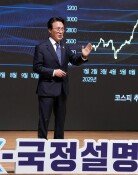IMF forecasts break economy next year
IMF forecasts break economy next year
Posted October. 12, 2022 07:44,
Updated October. 12, 2022 07:44
The International Monetary Fund (IMF) downgraded its outlook for Korea's economic growth rate in 2023 by 0.1 percentage points to 2.0 percent. It is the lowest figure in 10 years except for 2020, when COVID-19 was fiercely spreading. The IMF added that the worst was yet to come while projecting the economic growth rate for other regions, such as the U.S., Europe, and China, by 1 percent, 0.5 percent, and 4.4 percent, respectively.
Meanwhile, Korea's annual trade deficit surpassed 30 billion U.S. dollars for the first time. The benchmark Korea Composite Stock Price Index, or KOSPI, plummeted below the 2,200-point threshold on Tuesday due to plunging stock prices of global semiconductor companies amid the U.S. restrictions on China's semiconductor-related entities. The Korean won slid against the U.S. dollar as much as the 1,430 range per dollar.
The institution pointed out high inflation, the real estate bubble burst in China, and the prolonged war in Ukraine to lower its global economic growth rate forecast in 2023 by 0.2 percentage points at 2.7 percent. The outlook suggests that amid ongoing inflation pressures, China's property market will weaken further, accounting for 30 percent of the country's economy. Europe may experience a continued economic downturn due to Russia’s crunched natural gas supply. It also implies that Korea's key trading partners will suffer heavy economic slowdowns. At the same time, hardships from the weak Korean won driven by the "king dollar" strength and expensive raw material imports will likely continue.
Signs of a Korean economic recession are becoming more evident as well. The nation's trade balance, which recorded negative consecutively for the last six months until September, stood at a deficit of 3.8 billion U.S. dollars for the first days of the month. As the trade deficit for 2022 accumulates up to 32.7 billion U.S. dollars, Korea's annual trade balance this year may likely end up negative in 14 years since the global financial crisis.
The crisis may not stay within the real economy. Many note that the economic crisis is a complex combination of stagflation in the 1970s, the Asian financial crisis in the late 1990s, and the global financial crisis in 2008. Emerging economies running out of U.S. dollars are asking the IMF for bailouts. At the same time, a financial crisis looks imminent in the U.K. recently saw its pound currency plunge and its government bonds dipping.
The global economy is entering a "new normal" era defined by high-interest rates, high inflation, and high exchange rates. Raising the benchmark interest rate seems inevitable, even at the cost of economic slowdown and rising unemployment. Otherwise, the economy may decline due to high prices and currency crises. On top of that, Korea's export-driven economy is sandwiched between the U.S. and China in terms of technological competition while struggling with expensive raw material imports. Many are warning signals that our economy may mire into a low structural growth if we do not wisely handle the crisis this time. All national economic actors should be fully prepared for the impact and share the burden of weathering the crisis.




![넘치는 전재수 과거 사진들…유죄의 증거일까, 무죄의 증거일까[청계천 옆 사진관]](https://dimg.donga.com/c/138/175/90/1/wps/NEWS/IMAGE/2025/12/20/132997378.1.jpg)


